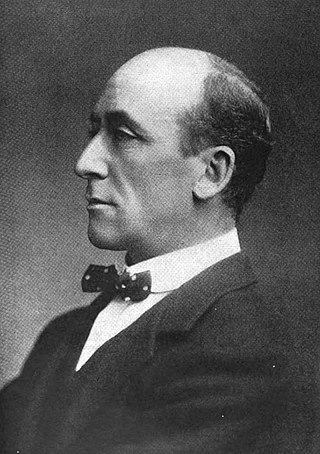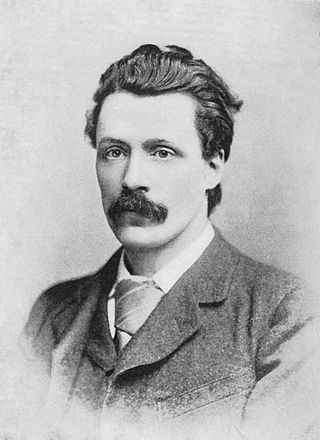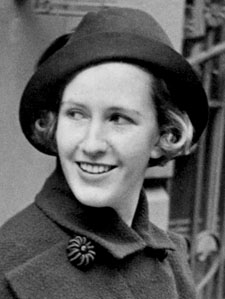Related Research Articles

James Branch Cabell was an American author of fantasy fiction and belles-lettres. Cabell was well-regarded by his contemporaries, including H. L. Mencken, Edmund Wilson, and Sinclair Lewis. His works were considered escapist and fit well in the culture of the 1920s, when they were most popular. For Cabell, veracity was "the one unpardonable sin, not merely against art, but against human welfare."

William Seward Burroughs II was an American writer and visual artist. He is widely considered a primary figure of the Beat Generation and a major postmodern author who influenced popular culture and literature. Burroughs wrote eighteen novels and novellas, six collections of short stories and four collections of essays, and five books have been published of his interviews and correspondences; he was initially briefly known by the pen name William Lee. He also collaborated on projects and recordings with numerous performers and musicians, made many appearances in films, and created and exhibited thousands of visual artworks, including his celebrated "Shotgun Art".

Algernon Henry Blackwood, CBE was an English broadcasting narrator, journalist, novelist and short story writer, and among the most prolific ghost story writers in the history of the genre. The literary critic S. T. Joshi stated, "His work is more consistently meritorious than any weird writer's except Dunsany's" and that his short story collection Incredible Adventures (1914) "may be the premier weird collection of this or any other century".

George Robert Gissing was an English novelist, who published 23 novels between 1880 and 1903. In the 1890s he was considered one of the three greatest novelists in England, and by the 1940s he had been recognised as a literary genius. Gissing's best-known works have reappeared in modern editions. They include The Nether World (1889), New Grub Street (1891) and The Odd Women (1893). He retains a small but devoted group of followers.
Methuen Publishing Ltd is an English publishing house. It was founded in 1889 by Sir Algernon Methuen (1856–1924) and began publishing in London in 1892. Initially Methuen mainly published non-fiction academic works, eventually diversifying to encourage female authors and later translated works. E. V. Lucas headed the firm from 1924 to 1938.

Michael Winter is a Canadian writer, the author of five novels and three collections of short stories.
Donald Eugene Pendleton was an American author of fiction and non-fiction books, best known for his creation of the fictional character Mack Bolan, which have sold hundreds of millions of copies worldwide since the character's 1969 debut. Since 1980 the Bolan adventure-espionage books were written by other authors under the Pendleton name, and initially under Pendleton's editorial guidance.
Elizabeth Curtis Sittenfeld is an American writer. She is the author of a collection of short stories, You Think it, I’ll Say It (2018), as well as seven novels: Prep (2005), the story of students at a Massachusetts prep school; The Man of My Dreams (2006), a coming-of-age novel and an examination of romantic love; American Wife (2008), a fictional story loosely based on the life of First Lady Laura Bush; Sisterland (2013), which tells the story of identical twins with psychic powers; Eligible (2016), a modern-day retelling of Pride and Prejudice; Rodham (2020), an alternate history political novel about the life of Hillary Clinton; and Romantic Comedy (2023), a romance between a comedy writer and a pop star.

Stephen Clarke is a British author. He writes mainly about France. He published six novels featuring a British protagonist named Paul West.

Peter Mayle was a British businessman turned author who moved to France in the 1980s. He wrote a series of bestselling memoirs of his life there, beginning with A Year in Provence (1989).

Julian Hawthorne was an American writer and journalist, the son of novelist Nathaniel Hawthorne and Sophia Peabody. He wrote numerous poems, novels, short stories, mysteries and detective fiction, essays, travel books, biographies, and histories.
It Happened in Boston? (1968) is a novel by Russell H. Greenan. It tells the story of an unreliable narrator, who is a disillusioned, paranoid painter, whose goal in life is to someday meet God and destroy him. He decided he wanted to hold God accountable for the evils in the world. The book follows a bizarre series of events in the lives of him and his painter friends and effectively documents his descent into paranoid delusions as he becomes more and more unreliable as a narrator leaving the reader to become more and more unsure about what exactly is happening in Boston.
Michael Raymond Donald Ashley is a British bibliographer, author and editor of science fiction, mystery, and fantasy.

Flowers for Algernon is a short story by American author Daniel Keyes, later expanded by him into a novel and subsequently adapted for film and other media. The short story, written in 1958 and first published in the April 1959 issue of The Magazine of Fantasy & Science Fiction, won the Hugo Award for Best Short Story in 1960. The novel was published in 1966 and was joint winner of that year's Nebula Award for Best Novel.
Tom Whalen is an American writer and scholar.
The Secret Life of Algernon is a 1997 Canadian comedy film directed by Charles Jarrott. It stars John Cullum and Carrie-Anne Moss in an early film appearance. It won an award at the 1998 Breckenridge Festival of Film. The film is based on the novel by Russell H. Greenan The Secret Life of Algernon Pendleton.

Swamplandia! is a 2011 novel by the American writer Karen Russell. The novel is set in the Ten Thousand Islands, off the southwest coast of Florida, it tells the story of the Bigtree family of alligator wrestlers who live in Swamplandia! an alligator-wrestling theme park. Swamplandia! is Russell's first novel. The book originated as a short story, titled "Ava Wrestles the Alligator", published in the Summer 2006 issue of the literary magazine Zoetrope: All-Story, when Russell was 24 years old, and later collected in her 2006 debut collection, St. Lucy's Home for Girls Raised by Wolves.

Nancy Hale was an American novelist and short-story writer. She received the O. Henry Award, a Benjamin Franklin magazine award, and the Henry H. Bellaman Foundation Award for fiction.

Samantha Spinner and the Super-Secret Plans is a children's mystery novel centered on an eponymous character, Samantha, an 11-year-old from Seattle. Her uncle Paul disappeared mysteriously and left her siblings expensive gifts. Her brother, Nipper, received the New York Yankees. Her sister, Buffy, received $2,400,000,000. Samantha received only a rusty red umbrella. Eventually, she discovered that the umbrella lining contains maps and diagrams to secret means of traveling around the globe.
According to some literary and religious studies scholars, modern Theosophy had a certain influence on contemporary literature, particularly in forms of genre fiction such as fantasy and science fiction. Researchers claim that Theosophy has significantly influenced the Irish literary renaissance of the late 19th and early 20th centuries, notably in such figures as W. B. Yeats and G. W. Russell.
References
- ↑ "The Secret Life of Algernon" . Retrieved 2007-07-11.
- 1 2 3 "Reviews Gallery, www.russellhgreenan.info" . Retrieved 2007-07-08.
- ↑ Playboy, October 1976, vol. 23, no. 10
- ↑ "www.RussellHGreenan.info" . Retrieved 2007-07-12.
- ↑ "Russell Henry Greenan". Legacy. Retrieved 25 July 2023.
- ↑ "Russell Henry Greenan". Echovita. Retrieved 25 July 2023.
- ↑ Walk-in; The Bric a Brac Man; Lend Me Your Ears Scotto, Virgil; Koski; Greenan, Russell; Stein, Aaron Marc, published by Walter J. Black
- 1 2 "Russell H Greenan". The Book Gallery. Retrieved 2007-06-30.
- ↑ "Diogenes Verlag 2010" . Retrieved 2015-11-18.
- ↑ "Random House Modern Library Rediscoveries Series" . Retrieved 2007-07-08.
- ↑ Tyler, Anne: “Flights of Fancy, Planes of Reality”, Book World, The Washington Post, June 27, 1982
- ↑ Block, Lawrence (25 February 1994). Telling Lies for Fun & Profit. HarperCollins. ISBN 0-688-13228-6.
- ↑ Block, Lawrence (1985). Writing the Novel from Plot to Print. Writer's Digest Books. ISBN 0-89879-208-8.
- ↑ Lehmann-Haupt, Christopher: "More Higgins, Greenan's Best", The New York Times, 5 November 1976
- ↑ Lehmann-Haupt, Christopher: "More Higgins, Greenan's Best", The New York Times, 14 March 1978
- ↑ "Tom Whalen" . Retrieved 2007-07-08.
- ↑ Whalen, T: The Birth of Death and Other Comedies: The novels of Russell H. Greenan, page 11. unpublished, 2006
- ↑ Whalen, T: "The Birth of Death and Other Comedies: The novels of Russell H. Greenan", page 13. unpublished, 2006
- ↑ Whalen, T: The Birth of Death and Other Comedies: The novels of Russell H. Greenan, page 126. unpublished, 2006
- ↑ name="http://www.RussellHGreenan.info”
- ↑ name="http://www.randomhouse.com/modernlibrary/greenan.html"
- ↑ Whalen, T: "The Birth of Death and Other Comedies: The novels of Russell H. Greenan", page 144. unpublished, 2006
- ↑ "www.RussellHGreenan.info" . Retrieved 2007-07-15.
- ↑ The Secret Life of Algernon (1997)
- ↑ Crime Fiction II: A Comprehensive Bibliography, 1749–1990 A Completely Revised and Updated Edition (Garland Reference Library of the Humanities) Routledge, 1994 ISBN 0-8240-6891-2